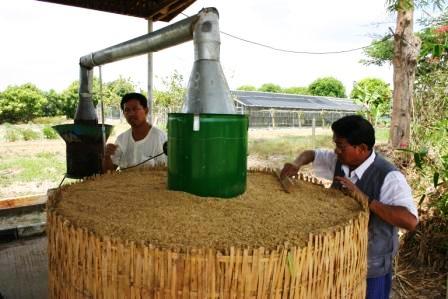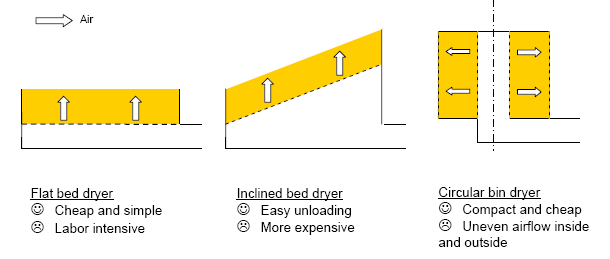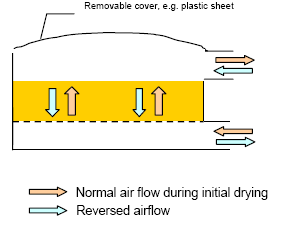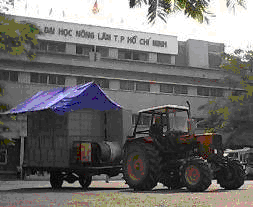Heated air drying
 Compared with traditional sun drying, heated air drying or mechanical drying allows for suitable drying air conditions to be set. In this method, drying can be carried out any time of the day or night.
Compared with traditional sun drying, heated air drying or mechanical drying allows for suitable drying air conditions to be set. In this method, drying can be carried out any time of the day or night.
Using mechanical dryers may also reduce the labor costs, especially if some form of mechanical turning or stirring of grain is practiced, as in the case of re-circulating dryers. Grain re-circulation allows to uniformly dry grains, and the automatic drying air temperature control to maximize the drying rate and at the same time reduce over-heating or over-drying. The following are options for heated air drying:
Batch dryer
Fixed-bed batch dryers usually have rectangular bins with plenum chamber underneath (flat bed dryer, box dryer, inclined bed dryer) or circular bins with central duct (Vietnamese low-cost dryer).
 Bed configuration of fixed bed batch dryers
Bed configuration of fixed bed batch dryers
The most common fixed bed dryers are flat bed dryers which have a very simple design. Grain is laid out on a perforated screen, and dried by forcing air from below. The air fan that provides the drying air is usually a simple axial flow fan that is powered by a diesel engine or by an electric motor. A kerosene burner or a biomass stove provides drying heat. The capacity of the dryer varies from one to ten tons.
Generally the drying floor is flat although dryers with reclining sections (to facilitate unloading) or vibrating sections (to facilitate stirring) exist as well. The height of the layer is usually 40 cm. The most common smaller dryers have a capacity of one to three tons per day with drying times of six to twelve hours. For drying of paddy in tropical areas, an air temperature of 40−45ºC is normally used with a heater capable of raising the air temperature 10−15ºC above ambient. An air velocity 0.15−0.25 m/s is required and typical fan power requirements are 1.5−2.5 kW /ton of paddy. The efficiency of these dryers as well as the head rice recovery is improved by stirring the grain during drying.
Other fixed bed dryers have a cylindrical duct made out of porous materials with a central duct for drying air delivery. These models save floor area and small scale units can be made out of very cheap materials such as woven bamboo mats thus keeping the dryer affordable for small farmers. However, an inherent problem of this dryer type lies in its circular design because the inner layers of the grain bulk contain less grain than the outer layers. Air velocities and thus drying potential are therefore larger close to the center of the dryer where the drying air enters the grain bulk and the air velocity decreases on its radial path through the grain. At the outlet, the drying rate which is already lower because of adsorbed water is further reduced by the lower specific air volume. This leads to even higher moisture gradients compared to flat bed dryers. Circular bin dryers made out of locally available materials, however, offer very affordable solutions to farm level drying, especially when they are used for ambient air drying with low temperatures where the moisture gradient is minimized.
To reduce the moisture gradient that develops during drying and to eliminate the need for mixing, some manufacturers have introduced devices for reversing the airflow in some fixed bed dryer models. This reduces the moisture gradient and thus improves the quality of the dried paddy but it adds to costs. Compared to the more complicated re-circulating batch dryers this is still a feasible solution where simple design is needed and operator skills are low. Principle (left) and example of a mobile reversible-flow batch dryer (right)
 Principle behind reversible-flow batch dryer
Principle behind reversible-flow batch dryer Mobile reversible-flow batch dryer
Mobile reversible-flow batch dryer
Re-circulating batch dryer
 Re-circulating batch dryers have been used for a long time in developed countries. In many Asian countries re-circulating batch dryers are increasingly being used by the private sector for producing better quality grain and for handling large amounts in the peak season safely.
Re-circulating batch dryers have been used for a long time in developed countries. In many Asian countries re-circulating batch dryers are increasingly being used by the private sector for producing better quality grain and for handling large amounts in the peak season safely.
However, the loading, unloading and circulation of grain create dust which needs to be collected in a collection system. In addition, it is recommended to pre-clean the grain prior to loading and drying. As with the flatbed dryer, re-circulating dryers come in a variety of capacities, from 2 tons (for seed production stations) up to 20 tons (for cooperative drying stations).
Depending on the flow of the drying air relative to the flow of the grain re-circulating batch dryers can be classified as cross flow ormixed flow re-circulating batch dryers.
In cross flow dryers the grains are not mixed while they are passing the drying section and being exposed to the hot drying air. This means that a moisture gradient develops in the drying section of the dryer. In the recirculation and tempering process this gradient is reduced because the wet and dry grains are mixed while they are being conveyed and subsequently moisture transfer happens from the wetter to the dryer grains. While this process is not optimal it still produces much better quality than a fixed bed dryer because the moisture gradients are much smaller.
Continuous flow
Conventional Continuous Flow Dryer
Although not very common in Southeast Asia continuous flow dryers are used by some larger milling enterprises that handle large volumes of wet paddy. Conventional continuous flow dryers usually consist of either mixing or non-mixing columnar dryers with different systems of airflow with respect to the grain (see figure).
- Cross flow dryers are of simple design. In the drying zone the grain moves downwards between two perforated metal sheets while the air moves horizontally through the grains. Since the grain is not mixed moisture gradients develop across the bed. They are also less susceptible to clogging than mixed flow dryers.
- In concurrent flow dryers the air moves in the same direction as the grain. This has the advantage that the air with the highest drying potential is in contact with the wettest grains. Higher air temperatures can be used for a fast drying process. Drying is rapid in the upper layers and slower in the lower layers, which suits the drying characteristics of paddy.
- In counter flow dryers the air moves upwards against the movement of the grain. This system is very energy efficient since the drying air continues to adsorb moisture on its way through the increasingly wet grain until the air outlet.
- Mixed flow dryers produce the best quality grains because of the continuous mixing effect. The inlet and outlet ducts can be placed in alternating pattern so that both concurrent flow and counter flow of the air can be achieved in one dryer.
A continuous flow dryer cannot be used as a stand alone machine but needs to be integrated in a larger system consisting of the dryer, several tempering bins and conveying equipment (Figure 12). It is not possible to dry the paddy in a continuous flow dryer from typical MC content down to levels for safe storage in one single pass. Typical drying MC reduction rates per pass are around 2%. One pass lasts 15-30 minutes at around 70ºC drying air temperature. Higher rates could be achieved by increasing either the drying air temperature or the retention time but both would negatively affect grain quality because of increased cracking. Continuous flow drying systems are therefore operated as multi-pass systems where the grain is moved to tempering bins for around 24 hours after each pass until the desired MC is reached (see also Section 3.3.4 Tempering). Sometimes the tempering bins are equipped with aeration facilities to cool down the grain with some additional low-temperature drying effect. Actual residence time in the continuous flow dryer in a multi pass system is 2-3 hours for a 10% reduction of moisture and is thus below that of a re-circulating batch dryer.
Continuous flow dryer operation needs to be carefully planned and requires good management in order to fully utilize the expensive equipment. In addition it requires continuous input of wet grains at a steady rate. The small scale farms, multitude of varieties, low labor and management skills and high capital investment needs are some of the reasons why continuous flow dryers are for the time being not feasible in most Asian countries.
Flash Dryer
Special continuous flow dryer types, which are used as first stage dryers in two-stage drying systems, are the rotary drum dryers in the Philippines and the fluidized bed dryers which were successfully commercialized in Thailand in the nineties. Both types use extremely high temperatures (up to 110-120°C) for rapid removal of the surface moisture and can only dry down to 18% MC without damaging the grains (see also "Two stage drying"). While the rotary drum dryers were mainly disseminated through government programs the fluidized bed dryers in Thailand were accepted by the private sector and are well integrated in combination drying systems that include either large scale in-store drying facilities with several hundred tons capacity or mixed flow heated air dryers for second stage drying to storage MC.
The fluidized bed dryer consists of a drying chamber with an air speed of around 2.3 m/s, a bed thickness of 10 cm in which the grain is exposed to the drying air for 10-15 minutes. Capacities of commercial units range from 1-10 t/h. A diesel burner or a rice hull furnace is used as heat source and a system for re-cycling 50-70% of the drying air is provided to improve energy efficiency. Typically head rice yields are reported to be up to 5% reduced compared to samples dried at ambient air while the effect on whiteness is minimal.
Guidelines on using dryers
The following are general recommendations for using mechanical grain dryers:
- When installing a dryer
Select the model carefully considering the technical requirements, economical feasibility and the volumes of paddy to be dried. - Get familiar with the operation of the dryer and try to understand the drying process. Insist on proper training to be provided by the manufacturer.
- Before loading the dryer
Clean the grain by removing fines and green, immature grains and materials other than grain. Fines reduce the airflow through rice causing increased drying time and wet spots. Green, immature grains and straw extend drying time and increased energy consumption. - In the dryer
Do not mix dry with wet paddy. The drying air gains moisture as it passes through the dryer and may cause the dry grains to fissure. - Monitor the drying air temperature, especially when drying seeds, to avoid heat stress that can cause cracking and to ensure the viability of the seeds.
- Monitor the moisture content and stop the drying process at the desired MC. Too high moisture content lead to qualitative losses and to discounted prices for wet paddy. Too low MC results in monetary losses because of unnecessary weight loss.
In general, mechanically dried grains will produce better quality rice compared to traditional sun drying. It will lead to more uniform drying of grain and higher milling yield and head rice recovery.
Since rice quality is becoming more important to rice consumers, medium-sized grain dryers have become a common sight throughout Asia. For production of premium quality rice or seed, mechanical drying with heated air dryers is highly recommended.